BNKG1002: Bank Analysis - Structure, Business Model, Risks, Consumers
VerifiedAdded on 2023/06/11
|12
|3718
|167
Report
AI Summary
This report provides an analysis of a commercial bank, focusing on its structure, business model, consumer base, and risk management strategies. Using the Bank of Maldives as an example, the report details the bank's organizational structure, including the roles of the CEO, board of directors, CFO, and risk management team. It examines various income sources, such as interest income and other sources like mutual fund distribution and wealth management services. The report also discusses the importance of customer relationship management (CRM) in meeting customer expectations and providing personalized services. Furthermore, it elaborates on the different forms of risk faced by banks, including credit risk and market risk, and the mitigation actions taken to overcome these risks, such as conducting thorough credit checks and using hedging contracts. The report highlights the significance of financial modeling in valuation, funding, and strategic decision-making, while also acknowledging its limitations in terms of time consumption and accuracy.
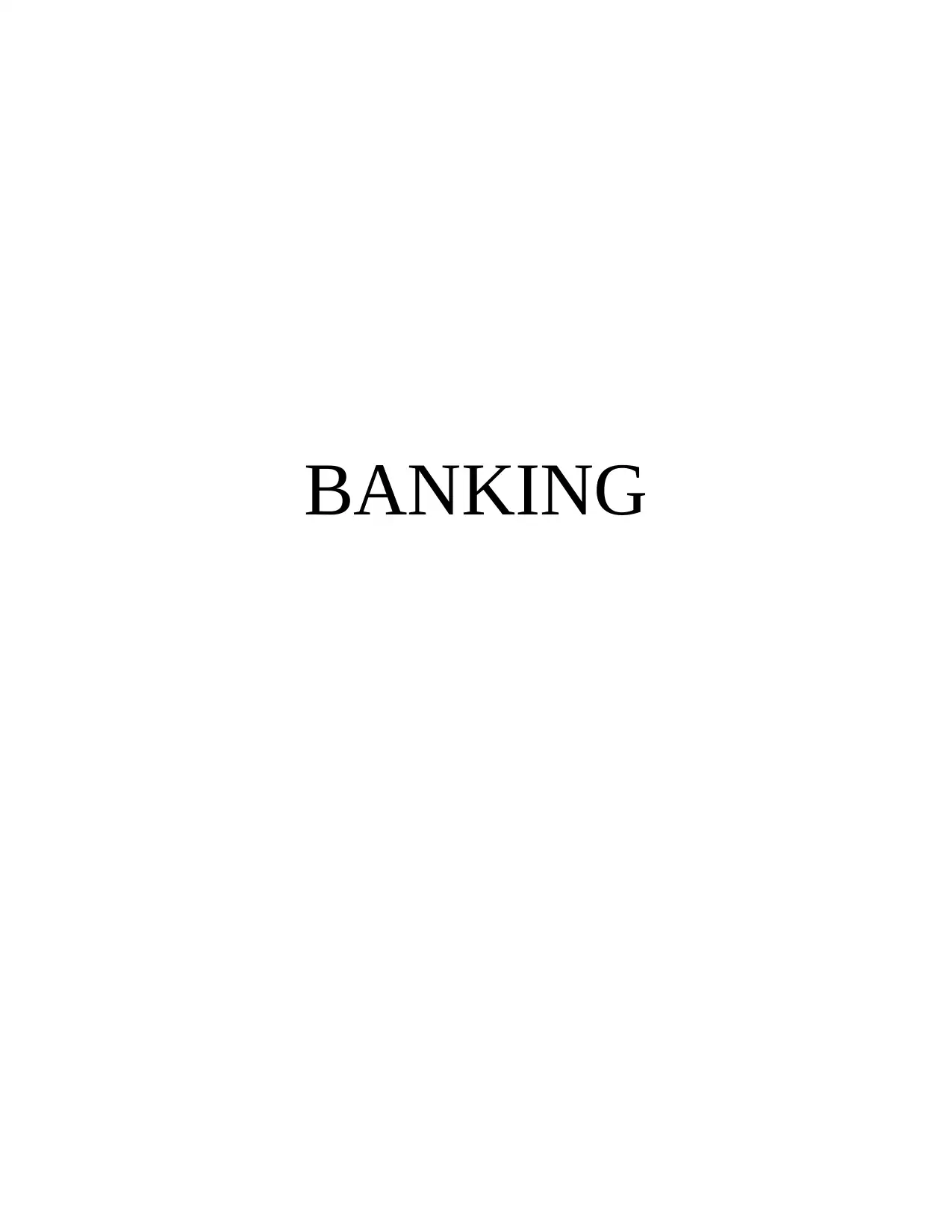
BANKING
Paraphrase This Document
Need a fresh take? Get an instant paraphrase of this document with our AI Paraphraser
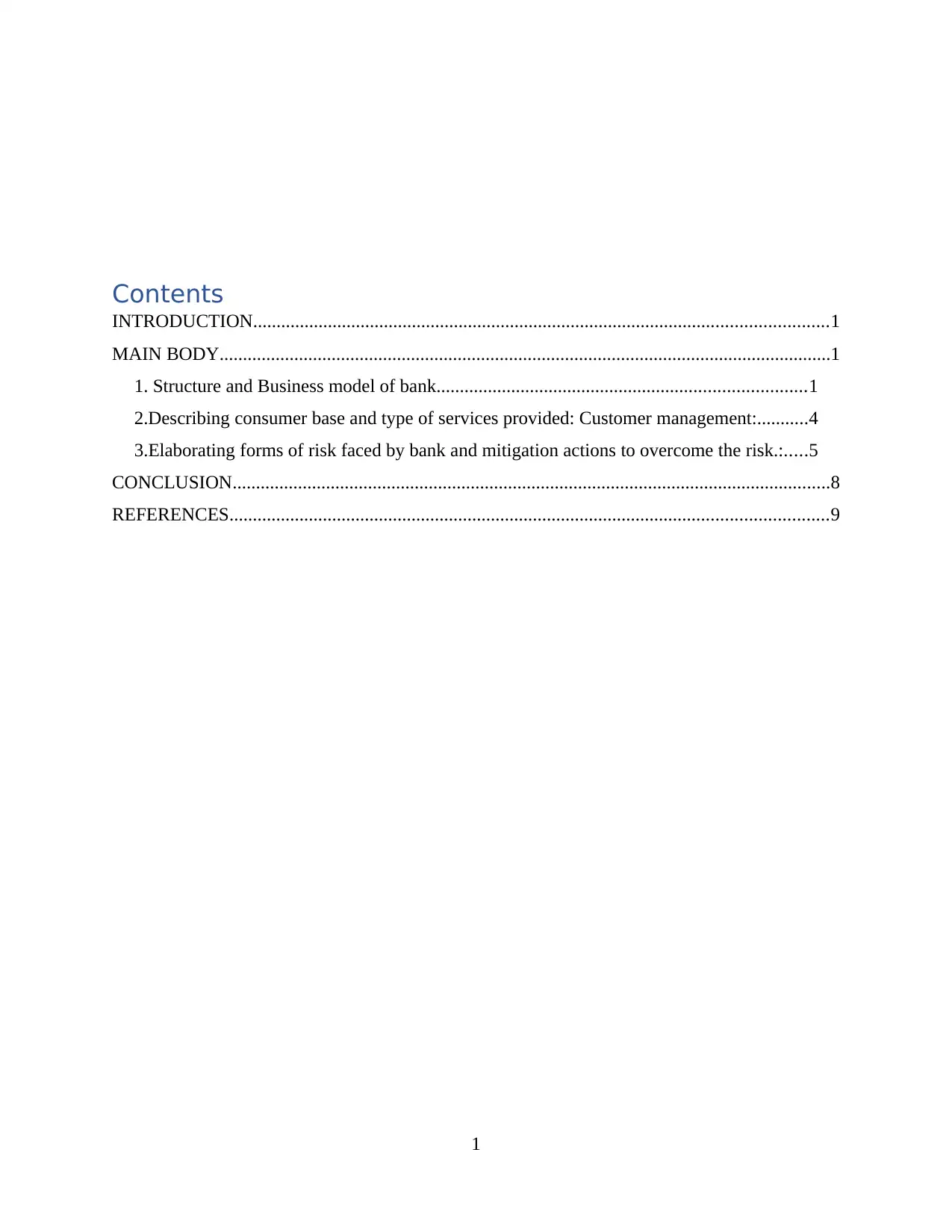
Contents
INTRODUCTION...........................................................................................................................1
MAIN BODY...................................................................................................................................1
1. Structure and Business model of bank...............................................................................1
2.Describing consumer base and type of services provided: Customer management:...........4
3.Elaborating forms of risk faced by bank and mitigation actions to overcome the risk.:.....5
CONCLUSION................................................................................................................................8
REFERENCES................................................................................................................................9
1
INTRODUCTION...........................................................................................................................1
MAIN BODY...................................................................................................................................1
1. Structure and Business model of bank...............................................................................1
2.Describing consumer base and type of services provided: Customer management:...........4
3.Elaborating forms of risk faced by bank and mitigation actions to overcome the risk.:.....5
CONCLUSION................................................................................................................................8
REFERENCES................................................................................................................................9
1
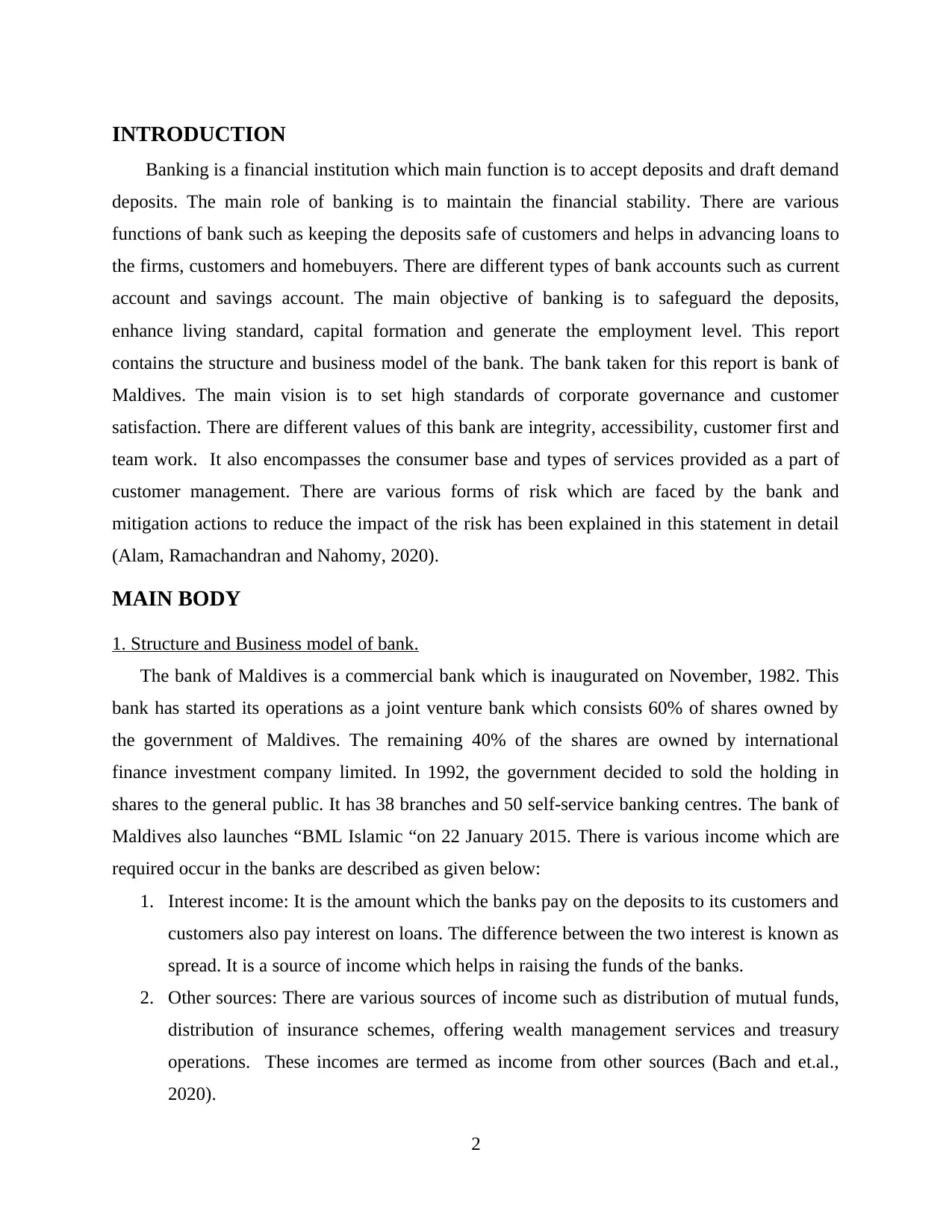
INTRODUCTION
Banking is a financial institution which main function is to accept deposits and draft demand
deposits. The main role of banking is to maintain the financial stability. There are various
functions of bank such as keeping the deposits safe of customers and helps in advancing loans to
the firms, customers and homebuyers. There are different types of bank accounts such as current
account and savings account. The main objective of banking is to safeguard the deposits,
enhance living standard, capital formation and generate the employment level. This report
contains the structure and business model of the bank. The bank taken for this report is bank of
Maldives. The main vision is to set high standards of corporate governance and customer
satisfaction. There are different values of this bank are integrity, accessibility, customer first and
team work. It also encompasses the consumer base and types of services provided as a part of
customer management. There are various forms of risk which are faced by the bank and
mitigation actions to reduce the impact of the risk has been explained in this statement in detail
(Alam, Ramachandran and Nahomy, 2020).
MAIN BODY
1. Structure and Business model of bank.
The bank of Maldives is a commercial bank which is inaugurated on November, 1982. This
bank has started its operations as a joint venture bank which consists 60% of shares owned by
the government of Maldives. The remaining 40% of the shares are owned by international
finance investment company limited. In 1992, the government decided to sold the holding in
shares to the general public. It has 38 branches and 50 self-service banking centres. The bank of
Maldives also launches “BML Islamic “on 22 January 2015. There is various income which are
required occur in the banks are described as given below:
1. Interest income: It is the amount which the banks pay on the deposits to its customers and
customers also pay interest on loans. The difference between the two interest is known as
spread. It is a source of income which helps in raising the funds of the banks.
2. Other sources: There are various sources of income such as distribution of mutual funds,
distribution of insurance schemes, offering wealth management services and treasury
operations. These incomes are termed as income from other sources (Bach and et.al.,
2020).
2
Banking is a financial institution which main function is to accept deposits and draft demand
deposits. The main role of banking is to maintain the financial stability. There are various
functions of bank such as keeping the deposits safe of customers and helps in advancing loans to
the firms, customers and homebuyers. There are different types of bank accounts such as current
account and savings account. The main objective of banking is to safeguard the deposits,
enhance living standard, capital formation and generate the employment level. This report
contains the structure and business model of the bank. The bank taken for this report is bank of
Maldives. The main vision is to set high standards of corporate governance and customer
satisfaction. There are different values of this bank are integrity, accessibility, customer first and
team work. It also encompasses the consumer base and types of services provided as a part of
customer management. There are various forms of risk which are faced by the bank and
mitigation actions to reduce the impact of the risk has been explained in this statement in detail
(Alam, Ramachandran and Nahomy, 2020).
MAIN BODY
1. Structure and Business model of bank.
The bank of Maldives is a commercial bank which is inaugurated on November, 1982. This
bank has started its operations as a joint venture bank which consists 60% of shares owned by
the government of Maldives. The remaining 40% of the shares are owned by international
finance investment company limited. In 1992, the government decided to sold the holding in
shares to the general public. It has 38 branches and 50 self-service banking centres. The bank of
Maldives also launches “BML Islamic “on 22 January 2015. There is various income which are
required occur in the banks are described as given below:
1. Interest income: It is the amount which the banks pay on the deposits to its customers and
customers also pay interest on loans. The difference between the two interest is known as
spread. It is a source of income which helps in raising the funds of the banks.
2. Other sources: There are various sources of income such as distribution of mutual funds,
distribution of insurance schemes, offering wealth management services and treasury
operations. These incomes are termed as income from other sources (Bach and et.al.,
2020).
2
⊘ This is a preview!⊘
Do you want full access?
Subscribe today to unlock all pages.

Trusted by 1+ million students worldwide
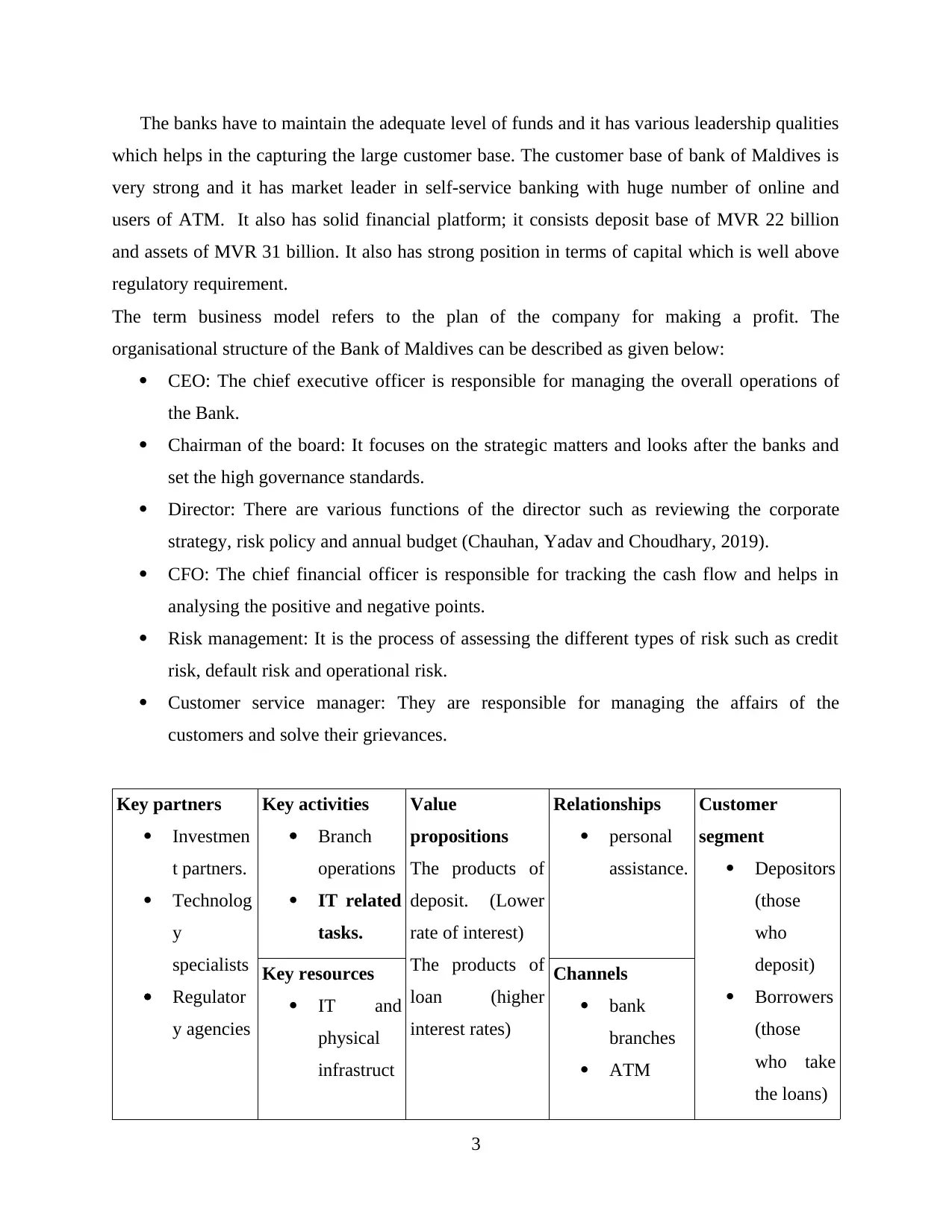
The banks have to maintain the adequate level of funds and it has various leadership qualities
which helps in the capturing the large customer base. The customer base of bank of Maldives is
very strong and it has market leader in self-service banking with huge number of online and
users of ATM. It also has solid financial platform; it consists deposit base of MVR 22 billion
and assets of MVR 31 billion. It also has strong position in terms of capital which is well above
regulatory requirement.
The term business model refers to the plan of the company for making a profit. The
organisational structure of the Bank of Maldives can be described as given below:
CEO: The chief executive officer is responsible for managing the overall operations of
the Bank.
Chairman of the board: It focuses on the strategic matters and looks after the banks and
set the high governance standards.
Director: There are various functions of the director such as reviewing the corporate
strategy, risk policy and annual budget (Chauhan, Yadav and Choudhary, 2019).
CFO: The chief financial officer is responsible for tracking the cash flow and helps in
analysing the positive and negative points.
Risk management: It is the process of assessing the different types of risk such as credit
risk, default risk and operational risk.
Customer service manager: They are responsible for managing the affairs of the
customers and solve their grievances.
Key partners
Investmen
t partners.
Technolog
y
specialists
Regulator
y agencies
Key activities
Branch
operations
IT related
tasks.
Value
propositions
The products of
deposit. (Lower
rate of interest)
The products of
loan (higher
interest rates)
Relationships
personal
assistance.
Customer
segment
Depositors
(those
who
deposit)
Borrowers
(those
who take
the loans)
Key resources
IT and
physical
infrastruct
Channels
bank
branches
ATM
3
which helps in the capturing the large customer base. The customer base of bank of Maldives is
very strong and it has market leader in self-service banking with huge number of online and
users of ATM. It also has solid financial platform; it consists deposit base of MVR 22 billion
and assets of MVR 31 billion. It also has strong position in terms of capital which is well above
regulatory requirement.
The term business model refers to the plan of the company for making a profit. The
organisational structure of the Bank of Maldives can be described as given below:
CEO: The chief executive officer is responsible for managing the overall operations of
the Bank.
Chairman of the board: It focuses on the strategic matters and looks after the banks and
set the high governance standards.
Director: There are various functions of the director such as reviewing the corporate
strategy, risk policy and annual budget (Chauhan, Yadav and Choudhary, 2019).
CFO: The chief financial officer is responsible for tracking the cash flow and helps in
analysing the positive and negative points.
Risk management: It is the process of assessing the different types of risk such as credit
risk, default risk and operational risk.
Customer service manager: They are responsible for managing the affairs of the
customers and solve their grievances.
Key partners
Investmen
t partners.
Technolog
y
specialists
Regulator
y agencies
Key activities
Branch
operations
IT related
tasks.
Value
propositions
The products of
deposit. (Lower
rate of interest)
The products of
loan (higher
interest rates)
Relationships
personal
assistance.
Customer
segment
Depositors
(those
who
deposit)
Borrowers
(those
who take
the loans)
Key resources
IT and
physical
infrastruct
Channels
bank
branches
ATM
3
Paraphrase This Document
Need a fresh take? Get an instant paraphrase of this document with our AI Paraphraser
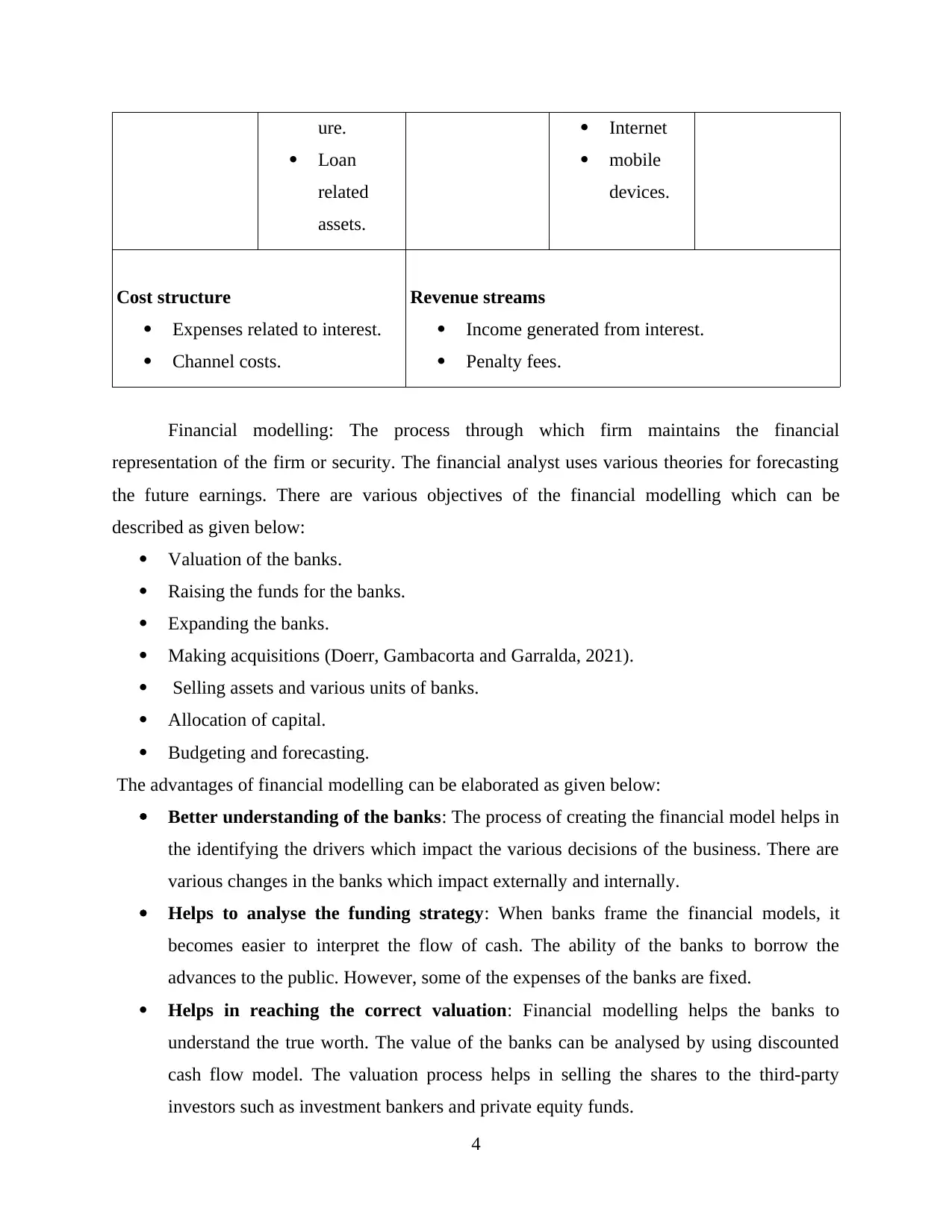
ure.
Loan
related
assets.
Internet
mobile
devices.
Cost structure
Expenses related to interest.
Channel costs.
Revenue streams
Income generated from interest.
Penalty fees.
Financial modelling: The process through which firm maintains the financial
representation of the firm or security. The financial analyst uses various theories for forecasting
the future earnings. There are various objectives of the financial modelling which can be
described as given below:
Valuation of the banks.
Raising the funds for the banks.
Expanding the banks.
Making acquisitions (Doerr, Gambacorta and Garralda, 2021).
Selling assets and various units of banks.
Allocation of capital.
Budgeting and forecasting.
The advantages of financial modelling can be elaborated as given below:
Better understanding of the banks: The process of creating the financial model helps in
the identifying the drivers which impact the various decisions of the business. There are
various changes in the banks which impact externally and internally.
Helps to analyse the funding strategy: When banks frame the financial models, it
becomes easier to interpret the flow of cash. The ability of the banks to borrow the
advances to the public. However, some of the expenses of the banks are fixed.
Helps in reaching the correct valuation: Financial modelling helps the banks to
understand the true worth. The value of the banks can be analysed by using discounted
cash flow model. The valuation process helps in selling the shares to the third-party
investors such as investment bankers and private equity funds.
4
Loan
related
assets.
Internet
mobile
devices.
Cost structure
Expenses related to interest.
Channel costs.
Revenue streams
Income generated from interest.
Penalty fees.
Financial modelling: The process through which firm maintains the financial
representation of the firm or security. The financial analyst uses various theories for forecasting
the future earnings. There are various objectives of the financial modelling which can be
described as given below:
Valuation of the banks.
Raising the funds for the banks.
Expanding the banks.
Making acquisitions (Doerr, Gambacorta and Garralda, 2021).
Selling assets and various units of banks.
Allocation of capital.
Budgeting and forecasting.
The advantages of financial modelling can be elaborated as given below:
Better understanding of the banks: The process of creating the financial model helps in
the identifying the drivers which impact the various decisions of the business. There are
various changes in the banks which impact externally and internally.
Helps to analyse the funding strategy: When banks frame the financial models, it
becomes easier to interpret the flow of cash. The ability of the banks to borrow the
advances to the public. However, some of the expenses of the banks are fixed.
Helps in reaching the correct valuation: Financial modelling helps the banks to
understand the true worth. The value of the banks can be analysed by using discounted
cash flow model. The valuation process helps in selling the shares to the third-party
investors such as investment bankers and private equity funds.
4
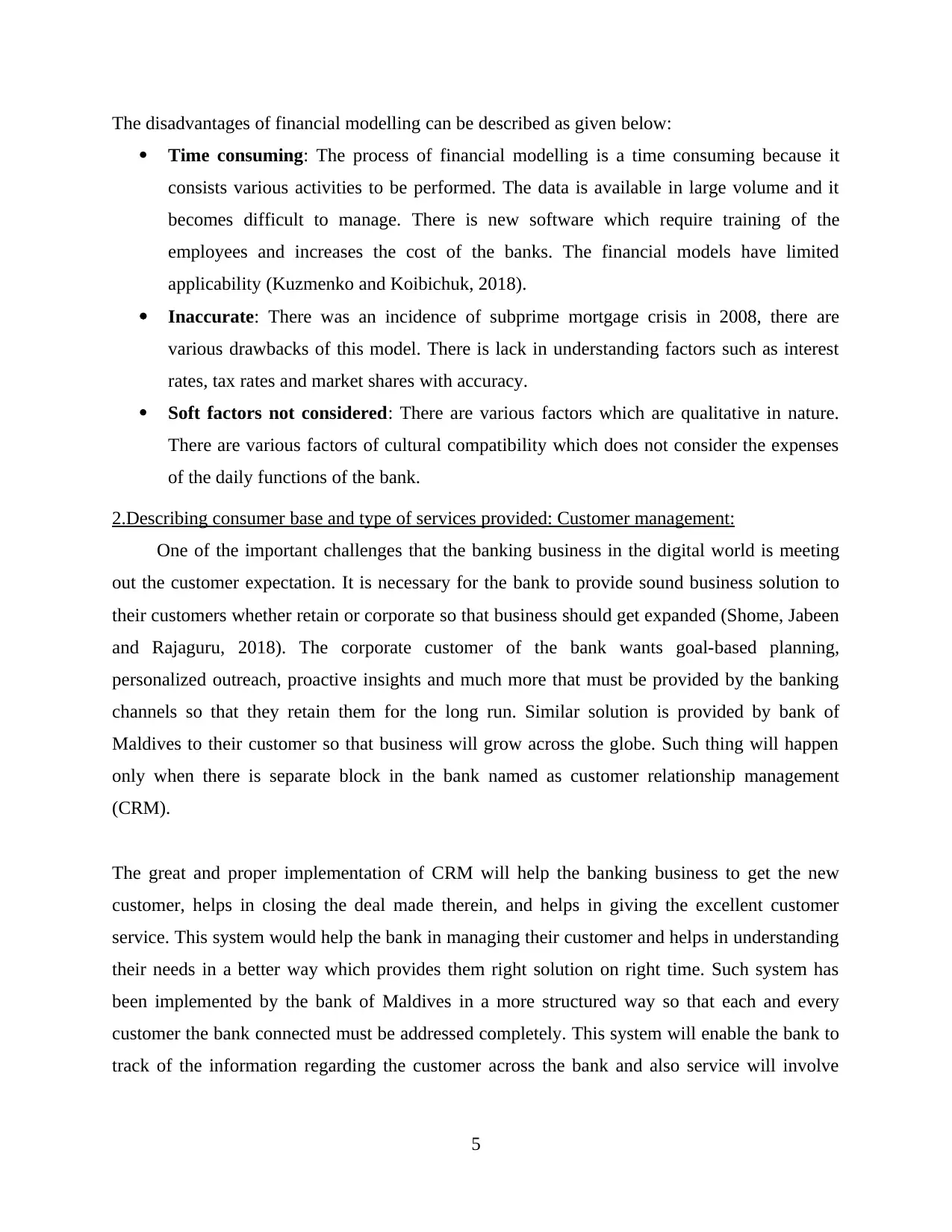
The disadvantages of financial modelling can be described as given below:
Time consuming: The process of financial modelling is a time consuming because it
consists various activities to be performed. The data is available in large volume and it
becomes difficult to manage. There is new software which require training of the
employees and increases the cost of the banks. The financial models have limited
applicability (Kuzmenko and Koibichuk, 2018).
Inaccurate: There was an incidence of subprime mortgage crisis in 2008, there are
various drawbacks of this model. There is lack in understanding factors such as interest
rates, tax rates and market shares with accuracy.
Soft factors not considered: There are various factors which are qualitative in nature.
There are various factors of cultural compatibility which does not consider the expenses
of the daily functions of the bank.
2.Describing consumer base and type of services provided: Customer management:
One of the important challenges that the banking business in the digital world is meeting
out the customer expectation. It is necessary for the bank to provide sound business solution to
their customers whether retain or corporate so that business should get expanded (Shome, Jabeen
and Rajaguru, 2018). The corporate customer of the bank wants goal-based planning,
personalized outreach, proactive insights and much more that must be provided by the banking
channels so that they retain them for the long run. Similar solution is provided by bank of
Maldives to their customer so that business will grow across the globe. Such thing will happen
only when there is separate block in the bank named as customer relationship management
(CRM).
The great and proper implementation of CRM will help the banking business to get the new
customer, helps in closing the deal made therein, and helps in giving the excellent customer
service. This system would help the bank in managing their customer and helps in understanding
their needs in a better way which provides them right solution on right time. Such system has
been implemented by the bank of Maldives in a more structured way so that each and every
customer the bank connected must be addressed completely. This system will enable the bank to
track of the information regarding the customer across the bank and also service will involve
5
Time consuming: The process of financial modelling is a time consuming because it
consists various activities to be performed. The data is available in large volume and it
becomes difficult to manage. There is new software which require training of the
employees and increases the cost of the banks. The financial models have limited
applicability (Kuzmenko and Koibichuk, 2018).
Inaccurate: There was an incidence of subprime mortgage crisis in 2008, there are
various drawbacks of this model. There is lack in understanding factors such as interest
rates, tax rates and market shares with accuracy.
Soft factors not considered: There are various factors which are qualitative in nature.
There are various factors of cultural compatibility which does not consider the expenses
of the daily functions of the bank.
2.Describing consumer base and type of services provided: Customer management:
One of the important challenges that the banking business in the digital world is meeting
out the customer expectation. It is necessary for the bank to provide sound business solution to
their customers whether retain or corporate so that business should get expanded (Shome, Jabeen
and Rajaguru, 2018). The corporate customer of the bank wants goal-based planning,
personalized outreach, proactive insights and much more that must be provided by the banking
channels so that they retain them for the long run. Similar solution is provided by bank of
Maldives to their customer so that business will grow across the globe. Such thing will happen
only when there is separate block in the bank named as customer relationship management
(CRM).
The great and proper implementation of CRM will help the banking business to get the new
customer, helps in closing the deal made therein, and helps in giving the excellent customer
service. This system would help the bank in managing their customer and helps in understanding
their needs in a better way which provides them right solution on right time. Such system has
been implemented by the bank of Maldives in a more structured way so that each and every
customer the bank connected must be addressed completely. This system will enable the bank to
track of the information regarding the customer across the bank and also service will involve
5
⊘ This is a preview!⊘
Do you want full access?
Subscribe today to unlock all pages.

Trusted by 1+ million students worldwide
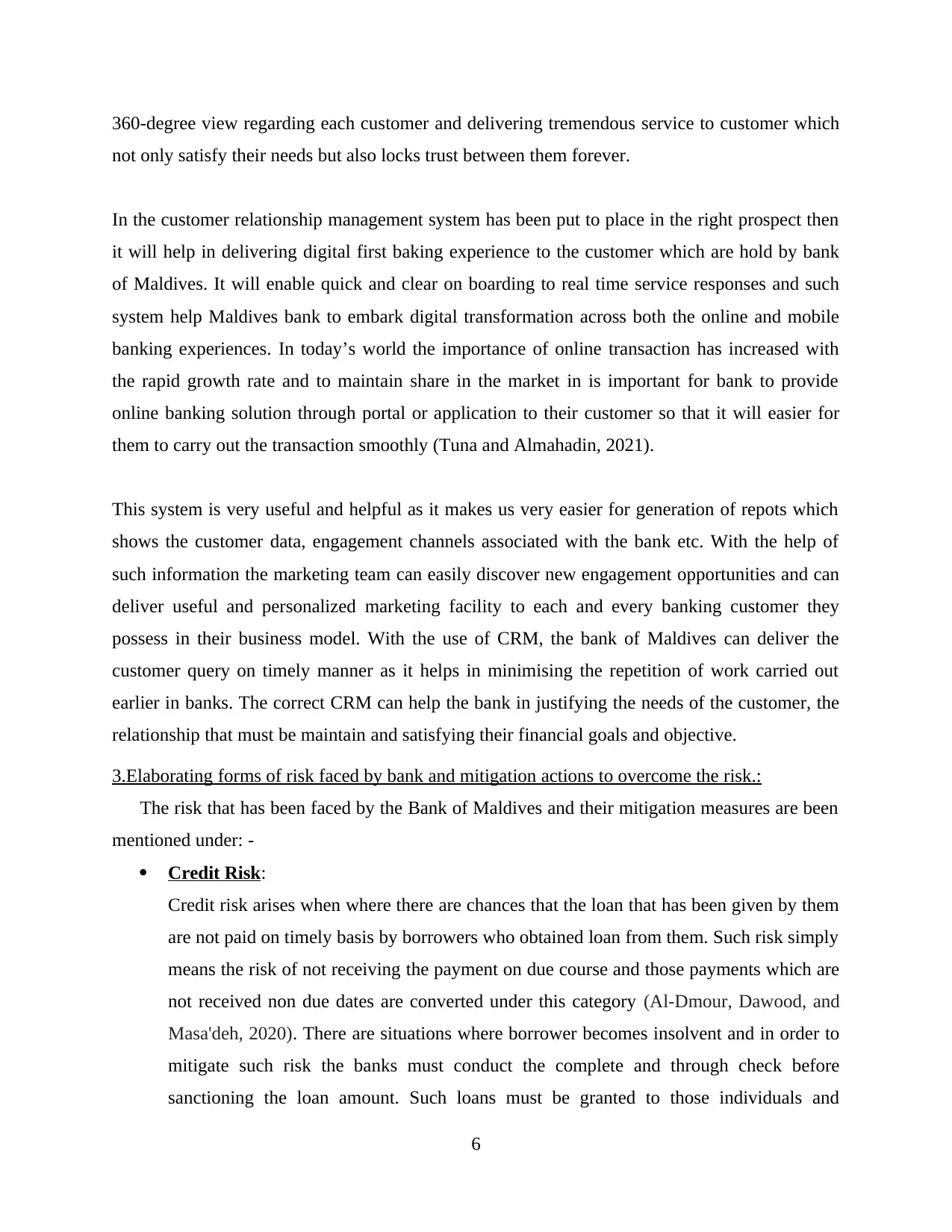
360-degree view regarding each customer and delivering tremendous service to customer which
not only satisfy their needs but also locks trust between them forever.
In the customer relationship management system has been put to place in the right prospect then
it will help in delivering digital first baking experience to the customer which are hold by bank
of Maldives. It will enable quick and clear on boarding to real time service responses and such
system help Maldives bank to embark digital transformation across both the online and mobile
banking experiences. In today’s world the importance of online transaction has increased with
the rapid growth rate and to maintain share in the market in is important for bank to provide
online banking solution through portal or application to their customer so that it will easier for
them to carry out the transaction smoothly (Tuna and Almahadin, 2021).
This system is very useful and helpful as it makes us very easier for generation of repots which
shows the customer data, engagement channels associated with the bank etc. With the help of
such information the marketing team can easily discover new engagement opportunities and can
deliver useful and personalized marketing facility to each and every banking customer they
possess in their business model. With the use of CRM, the bank of Maldives can deliver the
customer query on timely manner as it helps in minimising the repetition of work carried out
earlier in banks. The correct CRM can help the bank in justifying the needs of the customer, the
relationship that must be maintain and satisfying their financial goals and objective.
3.Elaborating forms of risk faced by bank and mitigation actions to overcome the risk.:
The risk that has been faced by the Bank of Maldives and their mitigation measures are been
mentioned under: -
Credit Risk:
Credit risk arises when where there are chances that the loan that has been given by them
are not paid on timely basis by borrowers who obtained loan from them. Such risk simply
means the risk of not receiving the payment on due course and those payments which are
not received non due dates are converted under this category (Al-Dmour, Dawood, and
Masa'deh, 2020). There are situations where borrower becomes insolvent and in order to
mitigate such risk the banks must conduct the complete and through check before
sanctioning the loan amount. Such loans must be granted to those individuals and
6
not only satisfy their needs but also locks trust between them forever.
In the customer relationship management system has been put to place in the right prospect then
it will help in delivering digital first baking experience to the customer which are hold by bank
of Maldives. It will enable quick and clear on boarding to real time service responses and such
system help Maldives bank to embark digital transformation across both the online and mobile
banking experiences. In today’s world the importance of online transaction has increased with
the rapid growth rate and to maintain share in the market in is important for bank to provide
online banking solution through portal or application to their customer so that it will easier for
them to carry out the transaction smoothly (Tuna and Almahadin, 2021).
This system is very useful and helpful as it makes us very easier for generation of repots which
shows the customer data, engagement channels associated with the bank etc. With the help of
such information the marketing team can easily discover new engagement opportunities and can
deliver useful and personalized marketing facility to each and every banking customer they
possess in their business model. With the use of CRM, the bank of Maldives can deliver the
customer query on timely manner as it helps in minimising the repetition of work carried out
earlier in banks. The correct CRM can help the bank in justifying the needs of the customer, the
relationship that must be maintain and satisfying their financial goals and objective.
3.Elaborating forms of risk faced by bank and mitigation actions to overcome the risk.:
The risk that has been faced by the Bank of Maldives and their mitigation measures are been
mentioned under: -
Credit Risk:
Credit risk arises when where there are chances that the loan that has been given by them
are not paid on timely basis by borrowers who obtained loan from them. Such risk simply
means the risk of not receiving the payment on due course and those payments which are
not received non due dates are converted under this category (Al-Dmour, Dawood, and
Masa'deh, 2020). There are situations where borrower becomes insolvent and in order to
mitigate such risk the banks must conduct the complete and through check before
sanctioning the loan amount. Such loans must be granted to those individuals and
6
Paraphrase This Document
Need a fresh take? Get an instant paraphrase of this document with our AI Paraphraser
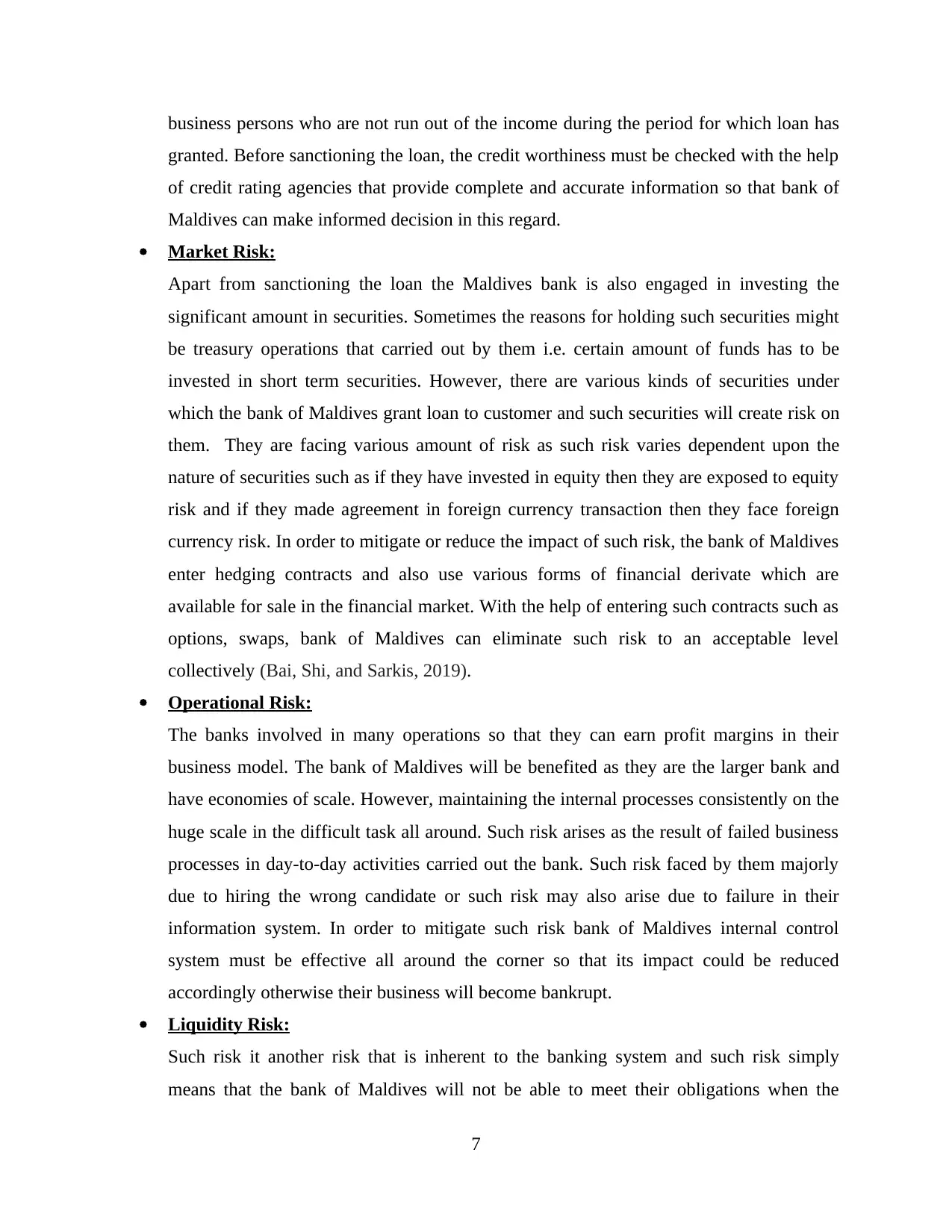
business persons who are not run out of the income during the period for which loan has
granted. Before sanctioning the loan, the credit worthiness must be checked with the help
of credit rating agencies that provide complete and accurate information so that bank of
Maldives can make informed decision in this regard.
Market Risk:
Apart from sanctioning the loan the Maldives bank is also engaged in investing the
significant amount in securities. Sometimes the reasons for holding such securities might
be treasury operations that carried out by them i.e. certain amount of funds has to be
invested in short term securities. However, there are various kinds of securities under
which the bank of Maldives grant loan to customer and such securities will create risk on
them. They are facing various amount of risk as such risk varies dependent upon the
nature of securities such as if they have invested in equity then they are exposed to equity
risk and if they made agreement in foreign currency transaction then they face foreign
currency risk. In order to mitigate or reduce the impact of such risk, the bank of Maldives
enter hedging contracts and also use various forms of financial derivate which are
available for sale in the financial market. With the help of entering such contracts such as
options, swaps, bank of Maldives can eliminate such risk to an acceptable level
collectively (Bai, Shi, and Sarkis, 2019).
Operational Risk:
The banks involved in many operations so that they can earn profit margins in their
business model. The bank of Maldives will be benefited as they are the larger bank and
have economies of scale. However, maintaining the internal processes consistently on the
huge scale in the difficult task all around. Such risk arises as the result of failed business
processes in day-to-day activities carried out the bank. Such risk faced by them majorly
due to hiring the wrong candidate or such risk may also arise due to failure in their
information system. In order to mitigate such risk bank of Maldives internal control
system must be effective all around the corner so that its impact could be reduced
accordingly otherwise their business will become bankrupt.
Liquidity Risk:
Such risk it another risk that is inherent to the banking system and such risk simply
means that the bank of Maldives will not be able to meet their obligations when the
7
granted. Before sanctioning the loan, the credit worthiness must be checked with the help
of credit rating agencies that provide complete and accurate information so that bank of
Maldives can make informed decision in this regard.
Market Risk:
Apart from sanctioning the loan the Maldives bank is also engaged in investing the
significant amount in securities. Sometimes the reasons for holding such securities might
be treasury operations that carried out by them i.e. certain amount of funds has to be
invested in short term securities. However, there are various kinds of securities under
which the bank of Maldives grant loan to customer and such securities will create risk on
them. They are facing various amount of risk as such risk varies dependent upon the
nature of securities such as if they have invested in equity then they are exposed to equity
risk and if they made agreement in foreign currency transaction then they face foreign
currency risk. In order to mitigate or reduce the impact of such risk, the bank of Maldives
enter hedging contracts and also use various forms of financial derivate which are
available for sale in the financial market. With the help of entering such contracts such as
options, swaps, bank of Maldives can eliminate such risk to an acceptable level
collectively (Bai, Shi, and Sarkis, 2019).
Operational Risk:
The banks involved in many operations so that they can earn profit margins in their
business model. The bank of Maldives will be benefited as they are the larger bank and
have economies of scale. However, maintaining the internal processes consistently on the
huge scale in the difficult task all around. Such risk arises as the result of failed business
processes in day-to-day activities carried out the bank. Such risk faced by them majorly
due to hiring the wrong candidate or such risk may also arise due to failure in their
information system. In order to mitigate such risk bank of Maldives internal control
system must be effective all around the corner so that its impact could be reduced
accordingly otherwise their business will become bankrupt.
Liquidity Risk:
Such risk it another risk that is inherent to the banking system and such risk simply
means that the bank of Maldives will not be able to meet their obligations when the
7
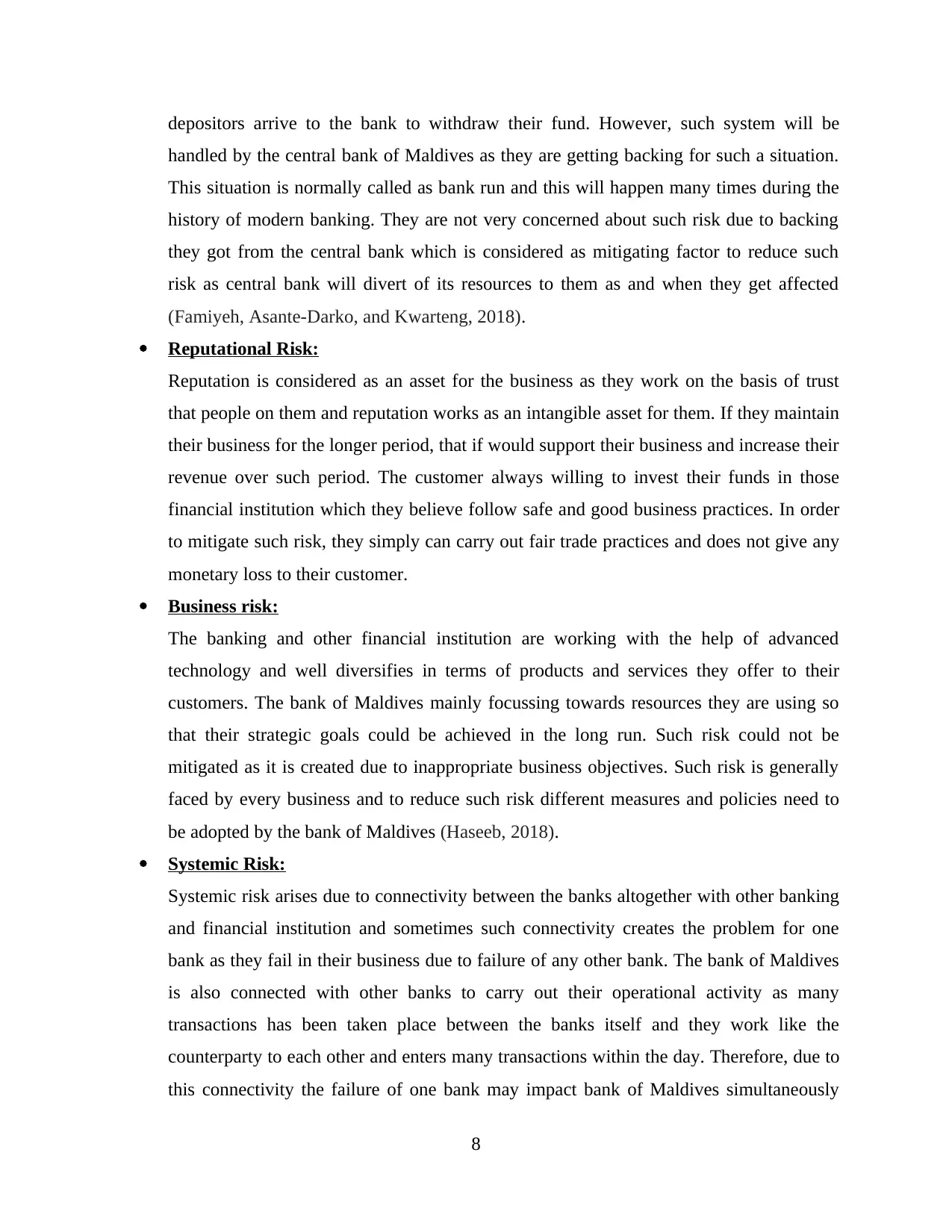
depositors arrive to the bank to withdraw their fund. However, such system will be
handled by the central bank of Maldives as they are getting backing for such a situation.
This situation is normally called as bank run and this will happen many times during the
history of modern banking. They are not very concerned about such risk due to backing
they got from the central bank which is considered as mitigating factor to reduce such
risk as central bank will divert of its resources to them as and when they get affected
(Famiyeh, Asante-Darko, and Kwarteng, 2018).
Reputational Risk:
Reputation is considered as an asset for the business as they work on the basis of trust
that people on them and reputation works as an intangible asset for them. If they maintain
their business for the longer period, that if would support their business and increase their
revenue over such period. The customer always willing to invest their funds in those
financial institution which they believe follow safe and good business practices. In order
to mitigate such risk, they simply can carry out fair trade practices and does not give any
monetary loss to their customer.
Business risk:
The banking and other financial institution are working with the help of advanced
technology and well diversifies in terms of products and services they offer to their
customers. The bank of Maldives mainly focussing towards resources they are using so
that their strategic goals could be achieved in the long run. Such risk could not be
mitigated as it is created due to inappropriate business objectives. Such risk is generally
faced by every business and to reduce such risk different measures and policies need to
be adopted by the bank of Maldives (Haseeb, 2018).
Systemic Risk:
Systemic risk arises due to connectivity between the banks altogether with other banking
and financial institution and sometimes such connectivity creates the problem for one
bank as they fail in their business due to failure of any other bank. The bank of Maldives
is also connected with other banks to carry out their operational activity as many
transactions has been taken place between the banks itself and they work like the
counterparty to each other and enters many transactions within the day. Therefore, due to
this connectivity the failure of one bank may impact bank of Maldives simultaneously
8
handled by the central bank of Maldives as they are getting backing for such a situation.
This situation is normally called as bank run and this will happen many times during the
history of modern banking. They are not very concerned about such risk due to backing
they got from the central bank which is considered as mitigating factor to reduce such
risk as central bank will divert of its resources to them as and when they get affected
(Famiyeh, Asante-Darko, and Kwarteng, 2018).
Reputational Risk:
Reputation is considered as an asset for the business as they work on the basis of trust
that people on them and reputation works as an intangible asset for them. If they maintain
their business for the longer period, that if would support their business and increase their
revenue over such period. The customer always willing to invest their funds in those
financial institution which they believe follow safe and good business practices. In order
to mitigate such risk, they simply can carry out fair trade practices and does not give any
monetary loss to their customer.
Business risk:
The banking and other financial institution are working with the help of advanced
technology and well diversifies in terms of products and services they offer to their
customers. The bank of Maldives mainly focussing towards resources they are using so
that their strategic goals could be achieved in the long run. Such risk could not be
mitigated as it is created due to inappropriate business objectives. Such risk is generally
faced by every business and to reduce such risk different measures and policies need to
be adopted by the bank of Maldives (Haseeb, 2018).
Systemic Risk:
Systemic risk arises due to connectivity between the banks altogether with other banking
and financial institution and sometimes such connectivity creates the problem for one
bank as they fail in their business due to failure of any other bank. The bank of Maldives
is also connected with other banks to carry out their operational activity as many
transactions has been taken place between the banks itself and they work like the
counterparty to each other and enters many transactions within the day. Therefore, due to
this connectivity the failure of one bank may impact bank of Maldives simultaneously
8
⊘ This is a preview!⊘
Do you want full access?
Subscribe today to unlock all pages.

Trusted by 1+ million students worldwide
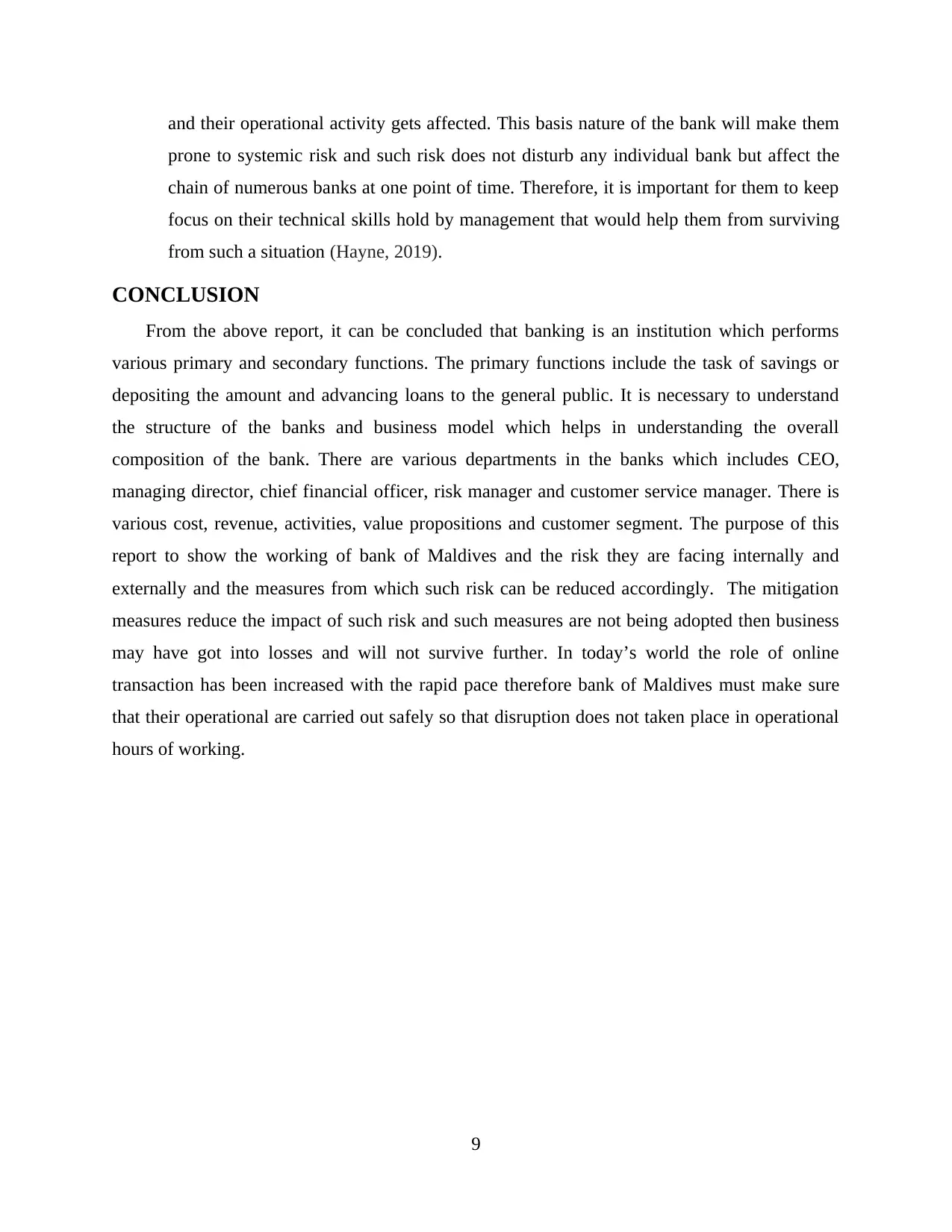
and their operational activity gets affected. This basis nature of the bank will make them
prone to systemic risk and such risk does not disturb any individual bank but affect the
chain of numerous banks at one point of time. Therefore, it is important for them to keep
focus on their technical skills hold by management that would help them from surviving
from such a situation (Hayne, 2019).
CONCLUSION
From the above report, it can be concluded that banking is an institution which performs
various primary and secondary functions. The primary functions include the task of savings or
depositing the amount and advancing loans to the general public. It is necessary to understand
the structure of the banks and business model which helps in understanding the overall
composition of the bank. There are various departments in the banks which includes CEO,
managing director, chief financial officer, risk manager and customer service manager. There is
various cost, revenue, activities, value propositions and customer segment. The purpose of this
report to show the working of bank of Maldives and the risk they are facing internally and
externally and the measures from which such risk can be reduced accordingly. The mitigation
measures reduce the impact of such risk and such measures are not being adopted then business
may have got into losses and will not survive further. In today’s world the role of online
transaction has been increased with the rapid pace therefore bank of Maldives must make sure
that their operational are carried out safely so that disruption does not taken place in operational
hours of working.
9
prone to systemic risk and such risk does not disturb any individual bank but affect the
chain of numerous banks at one point of time. Therefore, it is important for them to keep
focus on their technical skills hold by management that would help them from surviving
from such a situation (Hayne, 2019).
CONCLUSION
From the above report, it can be concluded that banking is an institution which performs
various primary and secondary functions. The primary functions include the task of savings or
depositing the amount and advancing loans to the general public. It is necessary to understand
the structure of the banks and business model which helps in understanding the overall
composition of the bank. There are various departments in the banks which includes CEO,
managing director, chief financial officer, risk manager and customer service manager. There is
various cost, revenue, activities, value propositions and customer segment. The purpose of this
report to show the working of bank of Maldives and the risk they are facing internally and
externally and the measures from which such risk can be reduced accordingly. The mitigation
measures reduce the impact of such risk and such measures are not being adopted then business
may have got into losses and will not survive further. In today’s world the role of online
transaction has been increased with the rapid pace therefore bank of Maldives must make sure
that their operational are carried out safely so that disruption does not taken place in operational
hours of working.
9
Paraphrase This Document
Need a fresh take? Get an instant paraphrase of this document with our AI Paraphraser
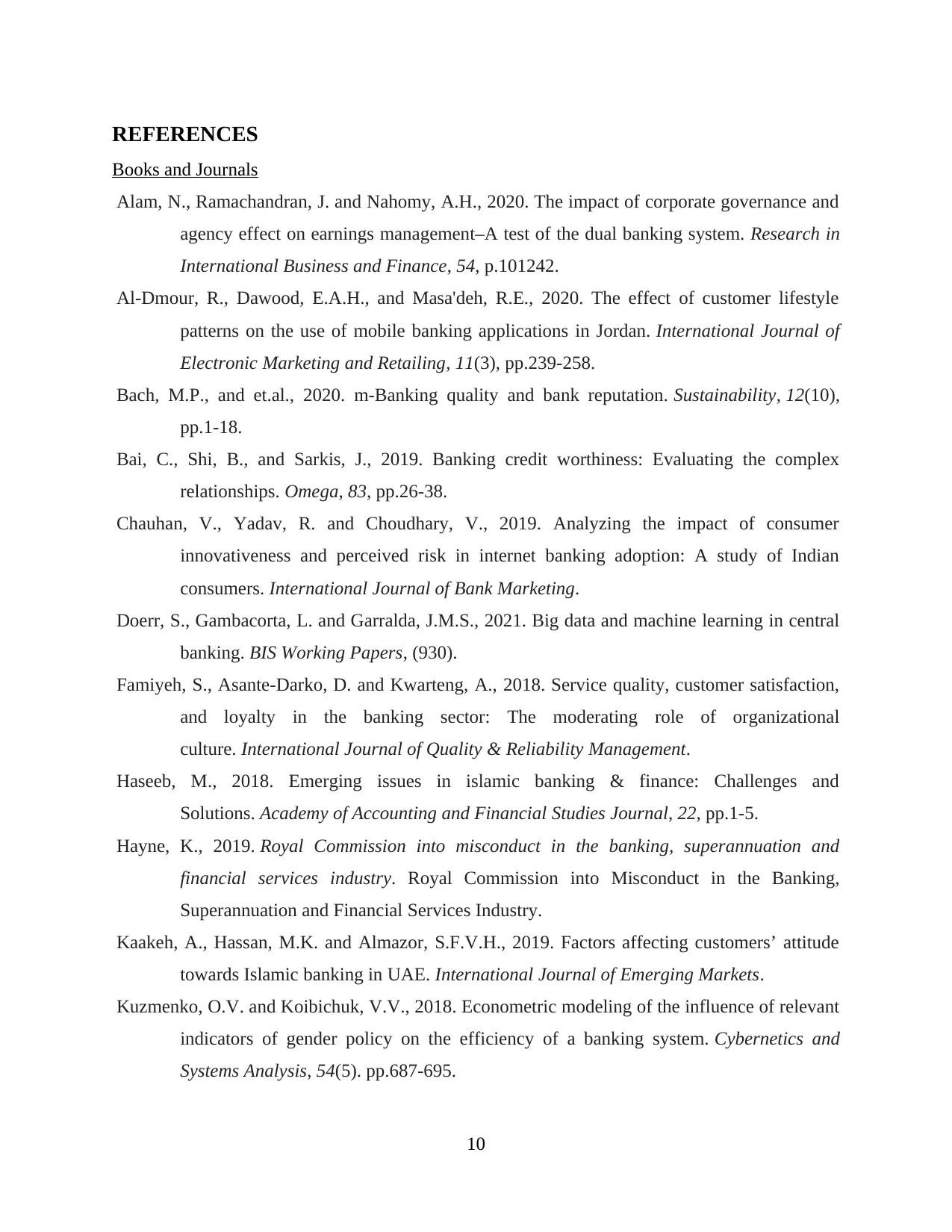
REFERENCES
Books and Journals
Alam, N., Ramachandran, J. and Nahomy, A.H., 2020. The impact of corporate governance and
agency effect on earnings management–A test of the dual banking system. Research in
International Business and Finance, 54, p.101242.
Al-Dmour, R., Dawood, E.A.H., and Masa'deh, R.E., 2020. The effect of customer lifestyle
patterns on the use of mobile banking applications in Jordan. International Journal of
Electronic Marketing and Retailing, 11(3), pp.239-258.
Bach, M.P., and et.al., 2020. m-Banking quality and bank reputation. Sustainability, 12(10),
pp.1-18.
Bai, C., Shi, B., and Sarkis, J., 2019. Banking credit worthiness: Evaluating the complex
relationships. Omega, 83, pp.26-38.
Chauhan, V., Yadav, R. and Choudhary, V., 2019. Analyzing the impact of consumer
innovativeness and perceived risk in internet banking adoption: A study of Indian
consumers. International Journal of Bank Marketing.
Doerr, S., Gambacorta, L. and Garralda, J.M.S., 2021. Big data and machine learning in central
banking. BIS Working Papers, (930).
Famiyeh, S., Asante-Darko, D. and Kwarteng, A., 2018. Service quality, customer satisfaction,
and loyalty in the banking sector: The moderating role of organizational
culture. International Journal of Quality & Reliability Management.
Haseeb, M., 2018. Emerging issues in islamic banking & finance: Challenges and
Solutions. Academy of Accounting and Financial Studies Journal, 22, pp.1-5.
Hayne, K., 2019. Royal Commission into misconduct in the banking, superannuation and
financial services industry. Royal Commission into Misconduct in the Banking,
Superannuation and Financial Services Industry.
Kaakeh, A., Hassan, M.K. and Almazor, S.F.V.H., 2019. Factors affecting customers’ attitude
towards Islamic banking in UAE. International Journal of Emerging Markets.
Kuzmenko, O.V. and Koibichuk, V.V., 2018. Econometric modeling of the influence of relevant
indicators of gender policy on the efficiency of a banking system. Cybernetics and
Systems Analysis, 54(5). pp.687-695.
10
Books and Journals
Alam, N., Ramachandran, J. and Nahomy, A.H., 2020. The impact of corporate governance and
agency effect on earnings management–A test of the dual banking system. Research in
International Business and Finance, 54, p.101242.
Al-Dmour, R., Dawood, E.A.H., and Masa'deh, R.E., 2020. The effect of customer lifestyle
patterns on the use of mobile banking applications in Jordan. International Journal of
Electronic Marketing and Retailing, 11(3), pp.239-258.
Bach, M.P., and et.al., 2020. m-Banking quality and bank reputation. Sustainability, 12(10),
pp.1-18.
Bai, C., Shi, B., and Sarkis, J., 2019. Banking credit worthiness: Evaluating the complex
relationships. Omega, 83, pp.26-38.
Chauhan, V., Yadav, R. and Choudhary, V., 2019. Analyzing the impact of consumer
innovativeness and perceived risk in internet banking adoption: A study of Indian
consumers. International Journal of Bank Marketing.
Doerr, S., Gambacorta, L. and Garralda, J.M.S., 2021. Big data and machine learning in central
banking. BIS Working Papers, (930).
Famiyeh, S., Asante-Darko, D. and Kwarteng, A., 2018. Service quality, customer satisfaction,
and loyalty in the banking sector: The moderating role of organizational
culture. International Journal of Quality & Reliability Management.
Haseeb, M., 2018. Emerging issues in islamic banking & finance: Challenges and
Solutions. Academy of Accounting and Financial Studies Journal, 22, pp.1-5.
Hayne, K., 2019. Royal Commission into misconduct in the banking, superannuation and
financial services industry. Royal Commission into Misconduct in the Banking,
Superannuation and Financial Services Industry.
Kaakeh, A., Hassan, M.K. and Almazor, S.F.V.H., 2019. Factors affecting customers’ attitude
towards Islamic banking in UAE. International Journal of Emerging Markets.
Kuzmenko, O.V. and Koibichuk, V.V., 2018. Econometric modeling of the influence of relevant
indicators of gender policy on the efficiency of a banking system. Cybernetics and
Systems Analysis, 54(5). pp.687-695.
10
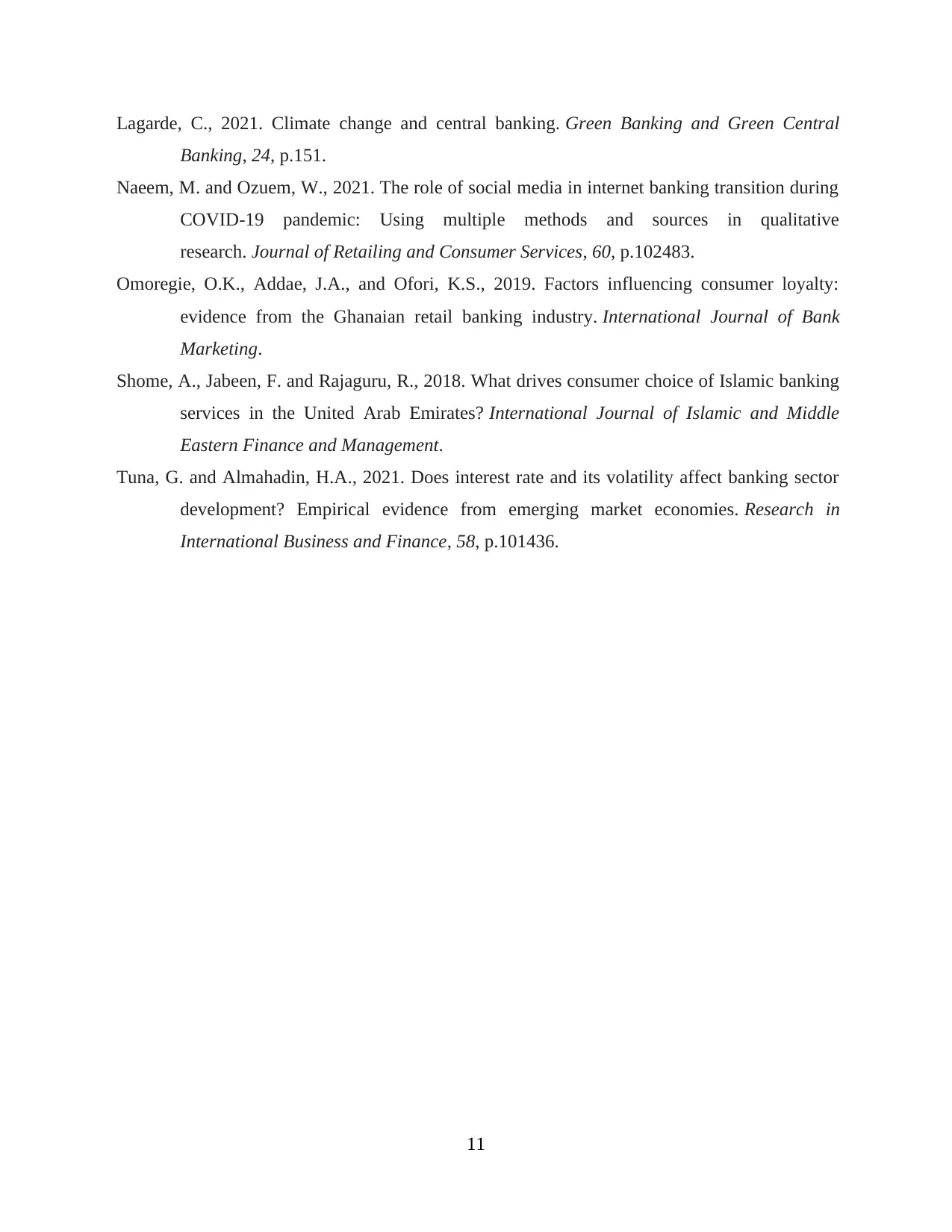
Lagarde, C., 2021. Climate change and central banking. Green Banking and Green Central
Banking, 24, p.151.
Naeem, M. and Ozuem, W., 2021. The role of social media in internet banking transition during
COVID-19 pandemic: Using multiple methods and sources in qualitative
research. Journal of Retailing and Consumer Services, 60, p.102483.
Omoregie, O.K., Addae, J.A., and Ofori, K.S., 2019. Factors influencing consumer loyalty:
evidence from the Ghanaian retail banking industry. International Journal of Bank
Marketing.
Shome, A., Jabeen, F. and Rajaguru, R., 2018. What drives consumer choice of Islamic banking
services in the United Arab Emirates? International Journal of Islamic and Middle
Eastern Finance and Management.
Tuna, G. and Almahadin, H.A., 2021. Does interest rate and its volatility affect banking sector
development? Empirical evidence from emerging market economies. Research in
International Business and Finance, 58, p.101436.
11
Banking, 24, p.151.
Naeem, M. and Ozuem, W., 2021. The role of social media in internet banking transition during
COVID-19 pandemic: Using multiple methods and sources in qualitative
research. Journal of Retailing and Consumer Services, 60, p.102483.
Omoregie, O.K., Addae, J.A., and Ofori, K.S., 2019. Factors influencing consumer loyalty:
evidence from the Ghanaian retail banking industry. International Journal of Bank
Marketing.
Shome, A., Jabeen, F. and Rajaguru, R., 2018. What drives consumer choice of Islamic banking
services in the United Arab Emirates? International Journal of Islamic and Middle
Eastern Finance and Management.
Tuna, G. and Almahadin, H.A., 2021. Does interest rate and its volatility affect banking sector
development? Empirical evidence from emerging market economies. Research in
International Business and Finance, 58, p.101436.
11
⊘ This is a preview!⊘
Do you want full access?
Subscribe today to unlock all pages.

Trusted by 1+ million students worldwide
1 out of 12
Related Documents
Your All-in-One AI-Powered Toolkit for Academic Success.
+13062052269
info@desklib.com
Available 24*7 on WhatsApp / Email
![[object Object]](/_next/static/media/star-bottom.7253800d.svg)
Unlock your academic potential
Copyright © 2020–2025 A2Z Services. All Rights Reserved. Developed and managed by ZUCOL.





